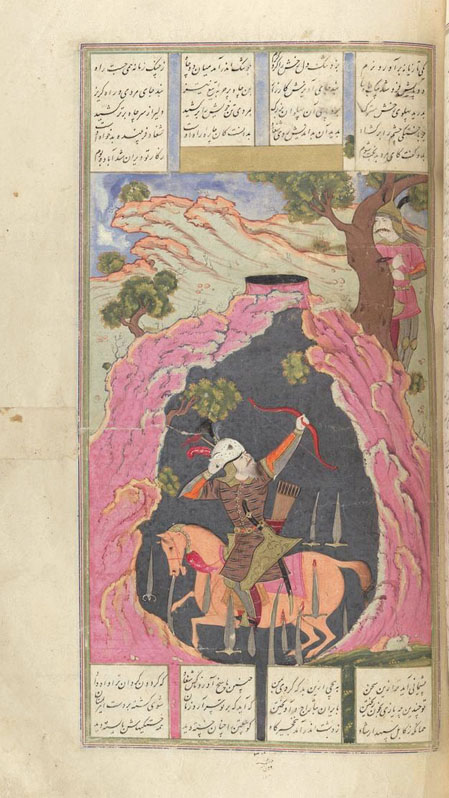Rostam Slays Šaghād then Dies
The painting depicts the episode at its usual point, just after Šaghād has been shot, but as Charles Melville (Cambridge Shahnama Project) has pointed out, the painting preceeds its location in the text by some 30 verses. The pit, into which Rostam and Raḵš have fallen, is shown in cross-section, in near identical fashion to the well that imprisoned Bižān on folios 176v and 184. But the artist has misunderstood the fundamentals of how the trap functioned; the pit depicted has only a narrow opening through which Rostam could hardly have fallen. In actuality, the pit would have to have had a wide mouth covered over with flimsy material in order to receive Rostam and the horse. The walls are portrayed in stone that appears like spongy pink coral. At the bottom of the pit are many pointed blades directed upward that pierce the body of the standing horse. Curiously, none penetrate, or even come close to Rostam, who is still upright in the saddle. Rostam looks upward, and to the rear. His left arm is outstretched with bow in hand, his right arm bent as if he had just let loose of an arrow. The arrow has, mysteriously, steered around the rock walls that are between Rostam and Šaghād, exited the pit, and found its mark. In the upper right is a tree, behind which Šaghād grasps the arrow imbedded in his chest. It is not clear in the painting whether the arrow had passed through the trunk as stated in the text, or alongside the tree. A craggy rock ledge appears behind the pit, and in the background the sky.
Painting: 23.25 x 16.5 cm. The text is written in four columns above and below the painting, with a rectangular frame enclosingpainting and text. There is a fine tear in the upper right and another at the bottom of the painting that goes across the entire page. Both faces are slightly damaged. In the lower margin, written in Moʿin’s hand, is the signature raqam zad kamina moʿin-e moṣavver, and the date 1104/1693. The signature of Fażl ʿAli does not appear on this folio, suggesting that Moʿin may have executed it without assistance. The painting is in excellent Moʿin style, and none of the details suggest anything other than the master’s hand. It is attributed by Jackson and Yohannan to Fażl ʿAli, and by Robinson to Moʿin with Fażl ʿAli assistance.
For two previous representations of this same scene by Moʿin, see Ms. D, folio 53, and Ms. F, no. 7.
Painting references:
J&Y_1914, pp.37, no.35 (not ill.).
Robinson, Cochran4_1972, p.79, no.35 (not ill.).
Cambridge Shahnameh Project
Text references: Warner, V, pp.271-73; Mohl, IV, p.578. Levy, pp.216-17.
Robert Eng
Last Updated: February 8, 2011 | Originally published: June 18, 2003
